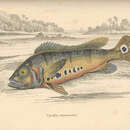Diagnostic Description
(
Anglèis
)
fornì da Fishbase
Diagnosis: This species is similar to C. kelberi and C. pleiozona in having three dark vertical bars on side, presence of a pronounced occipital bar in large specimens, absence of black or ocellated markings laterally on head, and presence of irregular dark blotches on anterior abdominal side. Differs from C. pleiozona by having less scales in a lateral row (68-87 vs. 84-93 in C. pleiozona) and typical absence of dark vertical bar anteriorly on caudal peduncle, and from C. kelberi by absence of light spots on anal and pelvic fins and lower caudal fin (Ref. 57716).
Life Cycle
(
Anglèis
)
fornì da Fishbase
Oviparous (Ref. 205). May spawn 3-4 times a year in batches of 50 to 100 eggs, each spawning lasting 2-3 hours (Ref. 50805).
Trophic Strategy
(
Anglèis
)
fornì da Fishbase
Specimens collected were from flood prone areas, but in the Amazon the biotopes are more varied. This fish forays along the shore where small fishes may be concentrated. Juveniles feed on shrimps, while adults are almost exclusively piscivore (Ref. 76754).
Biology
(
Anglèis
)
fornì da Fishbase
Specimens collected were from flood prone areas, but in the Amazon the biotopes are more varied. This fish forays along the shore where small fishes may be concentrated. Juveniles feed on shrimps, while adults are almost exclusively piscivore. Oviparous (Ref. 205). Males are sexually mature after one year while females mature after two years. During reproduction which is not markedly seasonal, large males develop a frontal hump and become territorial (Ref. 35237). Maximum length 80 cm TL (Ref. 35237).
- Recorder
- Crispina B. Binohlan
Importance
(
Anglèis
)
fornì da Fishbase
fisheries: minor commercial; aquarium: public aquariums
- Recorder
- Crispina B. Binohlan
Cichla monoculus
(
Anglèis
)
fornì da wikipedia EN
- licensa
- cc-by-sa-3.0
- drit d'autor
- Wikipedia authors and editors
Cichla monoculus: Brief Summary
(
Anglèis
)
fornì da wikipedia EN
Cichla monoculus, sometimes known as the tucanare peacock bass ("peacock bass" is also used for some of its relatives), is a very large species of cichlid, and a prized game fish. It is native to the Amazon basin in South America, but has also been introduced to regions outside its natural range (e.g., Florida and Hawaii). It reaches 80 cm (31 in) in length and 9 kg (20 lb) in weight.
- licensa
- cc-by-sa-3.0
- drit d'autor
- Wikipedia authors and editors

